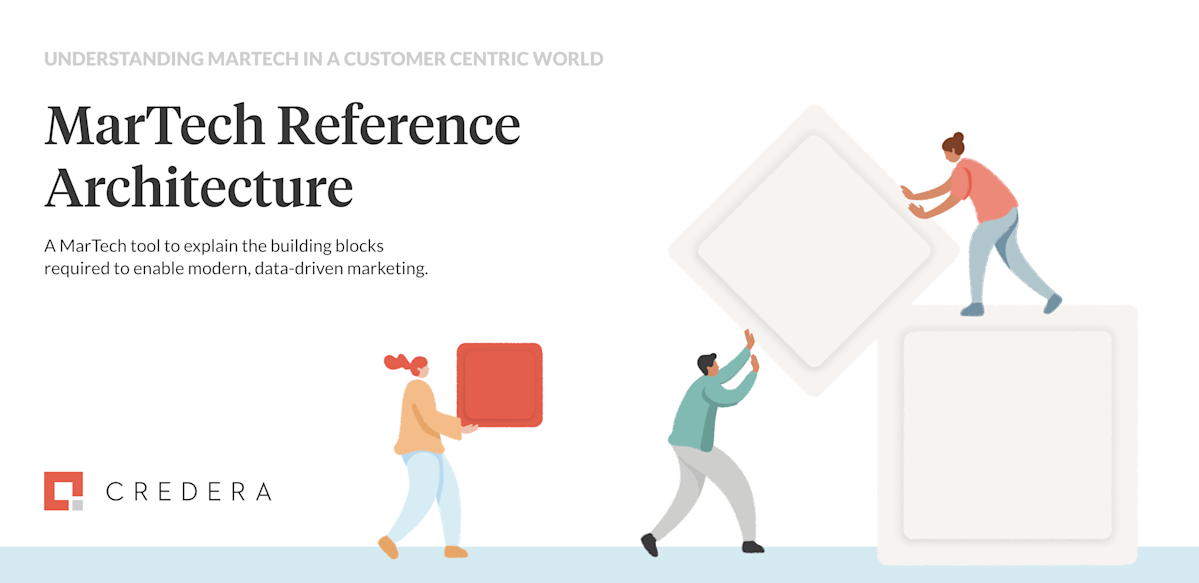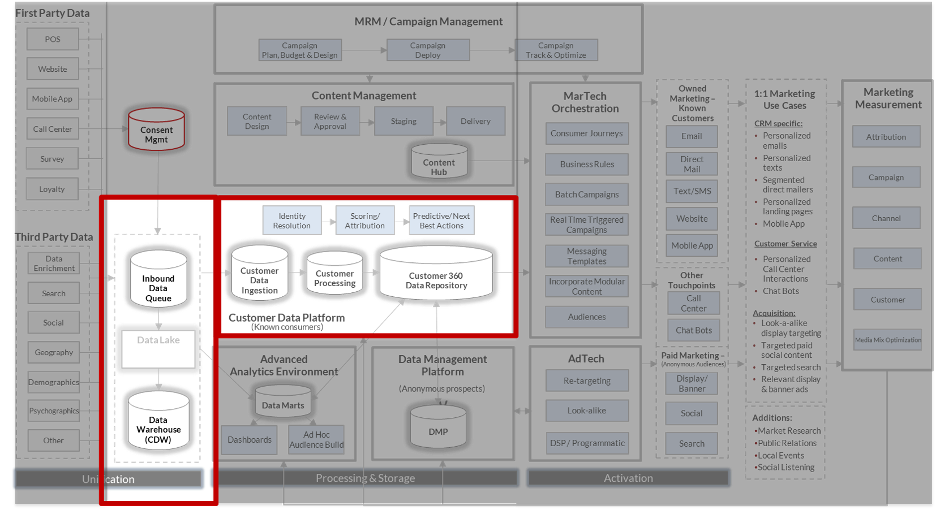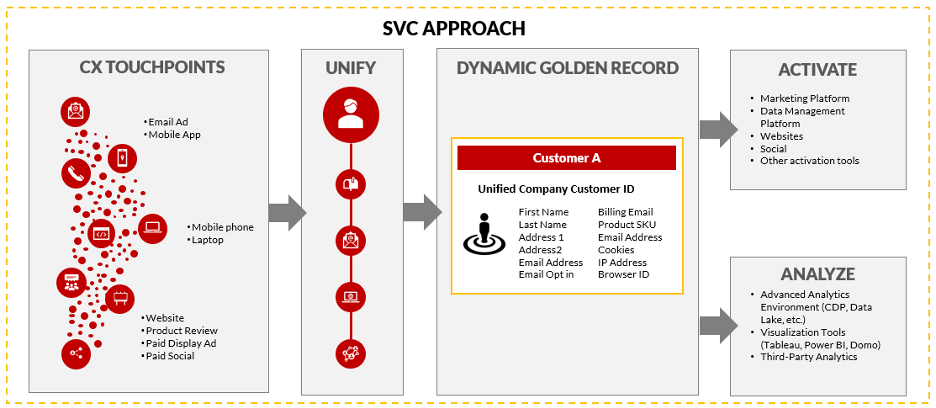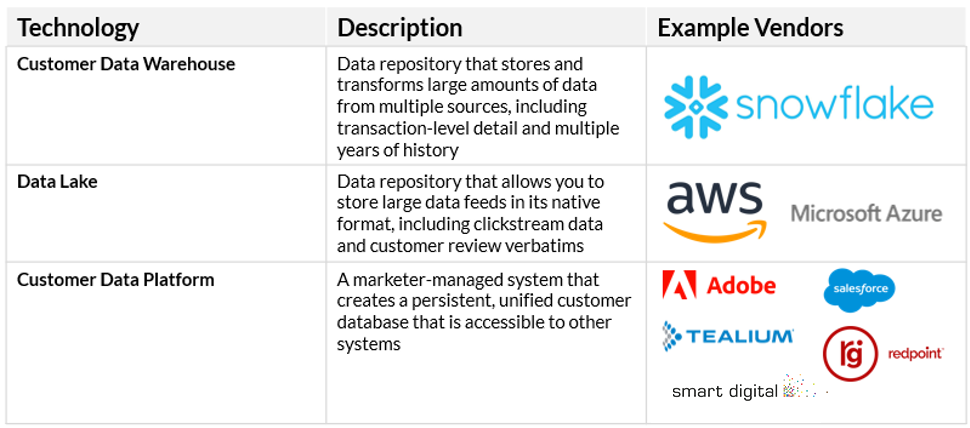Transformation
Aug 17, 2024
Credera’s MarTech Reference Architecture part 3: Single customer view

As we continue our series on Credera’s MarTech Reference Architecture, we focus on a critical capability of modern marketing – creating a unified, single customer view. Modern marketers require the capability to harness customer data from a growing number of sources to better understand customer behaviors, their preferences, and provide personalized marketing interactions.

As highlighted in the image above, the Single Customer View (SCV) resides in the center of a high-performing Marketing Technology architecture.
SCV defined
Customer data is the fuel for providing remarkable experiences. However, most marketers lack the unified view of their customer necessary to optimize these experiences. This holistic, consolidated view is commonly referred to as “Single Customer View” or SCV. This view stitches together all applicable first and third-party customer data sources. This process occurs in three primary steps: unification, classification, and activation.
Initially, all customer touchpoints are aggregated into a repository. Next, the touchpoints are unified to produce a “golden record” of all data points for a given customer. Next, the various online and offline data points are classified via pre-defined customer attributes, segmentation and predictive algorithms. This dynamic customer profile can then be utilized for deriving robust customer insights and/or omnichannel activation via owned and paid marketing channels to drive customer engagement and conversion.

Why it matters
A Single Customer View provides the ability for marketers to send the right message via the right channel at the right time. For example, a mature SCV will enable marketers to segment their customers based on relevant attributes to drive deeper insight into customer groups that are likely to purchase. This, in turn, helps marketers to fine-tune and personalize messaging, landing pages, customer offers, etc. to align with previously successful customer interactions among that same customer segment (i.e. look-alike targeting). Once a customer has converted, an SCV continuously optimizes the customer journey by identifying the next best action for that customer based on the context of their previous shopping and purchase behavior.
Top SCV technologies & players
Unifying, classifying, and activating customer data can be a complex challenge. Fortunately, a wide array of off-the-shelf technology vendors are available to provide many of the common functions required to manage a Single Customer View.

When selecting technology providers, it is important to start with a prioritized set of marketing use cases and a solid understanding of how the Single Customer View will interact with other marketing technologies (both existing and planned).
3 keys for driving SCV maturity
The process of constructing a mature single view will differ from company to company given their current marketing ecosystem. Developing a phased roadmap based on current state capabilities and target future state will enable marketers to identify how they can steadily move up the maturity curve. With this approach in mind, consider these guiding principals for assessing SCV maturity:
1. Centralized customer data
One of the primary keys for driving customer data maturity is to establish a centralized access area for all customer data sources. All applicable customer data sources should be available for unification, classification, and analytics/activation processes. This can be achieved via custom-built or off-the-shelf solutions including a data warehouse, a data lake, and/or a Customer Data Platform (CDP).
2. Unification and identity resolution – Stitch together PII and anonymous data
After a centralized customer data repository is established, the next step in driving maturity is to build a dynamic customer profile. This is achieved by continuously stitching together customer attributes from raw data sources to add new elements to the customer golden record. A dynamic customer profile will enable meaningful customer segmentation and support personalized data activation.
3. Apply AI/ML for predictive analytics/actions
Once an initial SCV is created, machine learning and artificial intelligence should be leveraged to identify patterns in customer data (e.g. demographics, behaviors, previous interactions, etc.) to model the next best action for a given customer. This specific action represents the next step in the customer journey with the highest likelihood of conversion in the context of other customers previous interactions. This enables your approach to be intelligent and adaptable as your customer journeys and products evolve over time.
Current trends and considerations
These two considerations can help guide you on your way to creating an SCV that works for your organization and is sustainable in the long run.
1. Use case-driven, phased approach:
Prior to selecting an SCV partner, consider utilizing a use case-driven approach. This means looking at your customer journey from start to finish and identifying the tactics that would drive your key metrics (i.e. awareness, conversion, engagement, etc.). For example, many brands are increasing the personalization level of email messages. If this use case is important, it should drive your questioning and proof of concept demos when exploring SCV solutions.
2. AI/ML enablement build vs buy vs blended:
Marketing organizations, in coordination with IT, should assess if their ML/AI need is specific to their organization, or common across the industry. Building a custom solution may be the right fit if the need is unique to your organization. If the desired solution is not specific to your organization, and common across the industry, readily available solutions from SaaS vendors will likely foot the bill. Of course, the desired solution may not be so black and white. Thankfully, many SaaS vendors support the ability to connect home-built solutions with their products
Up next
In our next installment of the MarTech Reference Architecture overview, we will talk about the importance of “Intelligent Content.” As a quick preview, “Intelligent Content” is the enablement of personalized content at scale through modular, reusable content that is dynamically served to the right customer at the right time through the right channel.
Overview of articles in the series:
Part 3: Single View of Customer
Interested in finding out more about how to construct a Single Customer View? Read more about the 6 key steps to building and leveraging a Single Customer View or reach out to one of our MarTech experts. We’d love to help your business assess your current customer data strategy and architecture and build a roadmap that sets you up for long-term success.
Contact Us
Ready to achieve your vision? We're here to help.
We'd love to start a conversation. Fill out the form and we'll connect you with the right person.
Searching for a new career?
View job openings





